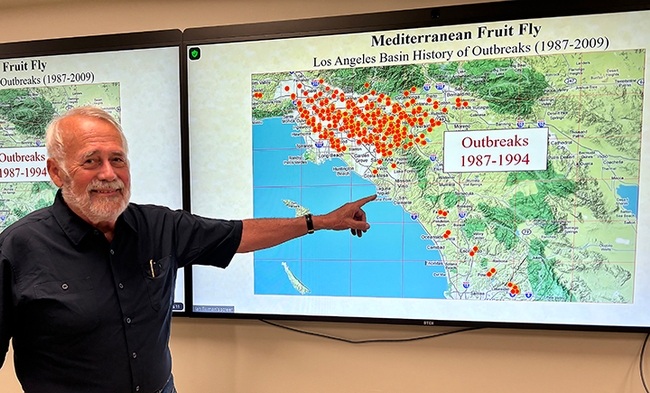If you missed UC Davis distinguished professor James R. Carey's well-attended seminar on "California's Fruit Fly Invasion: A 70-Year Struggle Nears Critical Mass," it's now online on YouTube.
His seminar, which took place June 3 in Briggs Hall, UC Davis, and on Zoom, drew global interest, stretching as far as Australia.
Carey pointed out that Callfornia has "the largest agricultural industry in the United States ($55 billion), is the fifth largest worldwide supplier of agricultural produces, grows more than 200 different crops, and "most fruit crops have been attacked by multiple tephritid species."
The California Department of Food and Agriculture (CDFA) reported that the first Mediterranean fruit fly (medfly) outbreak occurred on June 5, 1980, he said, and as of June 3, the state has detected 18 total species of fruit flies in 350 cities, amounting to 11,000 detections.
In his hour-long seminar, Carey presented an overview of the long-developing crisis, discussed lessons learned from analysis of fruit fly detection databases, and argued that "in order to have any chance at stemming this ever-rising tide, CDFA and the USDA urgently need to switch from their historic, ad hoc eradication strategy to a new one that is evidence-based and far more scientific."
In the closing moments, he asked "Why have oriental fruit fly outbreaks been occurring annually for the past 60 years in California?"
Because, he said, the fruit flies are "permanently established."
Carey, a 44-year member of the UC Davis faculty who is retiring in June, and a senior scholar in the Center for the Economics and Demography of Aging at UC Berkeley, researches insect biodemography, mortality dynamics, and insect invasion biology. He holds a doctorate in entomology from UC Berkeley (1980).
Carey served on the CDFA's Medfly Scientific Advisory Panel from 1987-1994, testified to the California Legislature "Committee of the Whole" in 1990 on the Medfly Crisis in California, and authored the paper "Establishment of the Mediterranean Fruit Fly in California" (1991, Science 258, 457).
He is a fellow of four professional societies: Entomological Society of America, the American Association for the Advancement of Science, the California Academy of Sciences, and the Gerontological Society of America. He is former director (2003-13) of a 11-university consortium funded by the National Institute on Aging (NIH/P01) on the evolutionary ecology of lifespan. He co-authored the book “Biodemography: An Introduction to Concepts and Methods” (Carey, J. R. and D. Roach. 2020; Princeton University Press) and authored the books, “Demography for Biologists (Oxford University Press 1993), Longevity (Princeton University Press, 2003), and Longevity Records: Life Spans of Mammals, Birds, Amphibians and Reptiles (Odense, 2000) as well as more than 250 journal articles and book chapters.
Attached Images:
